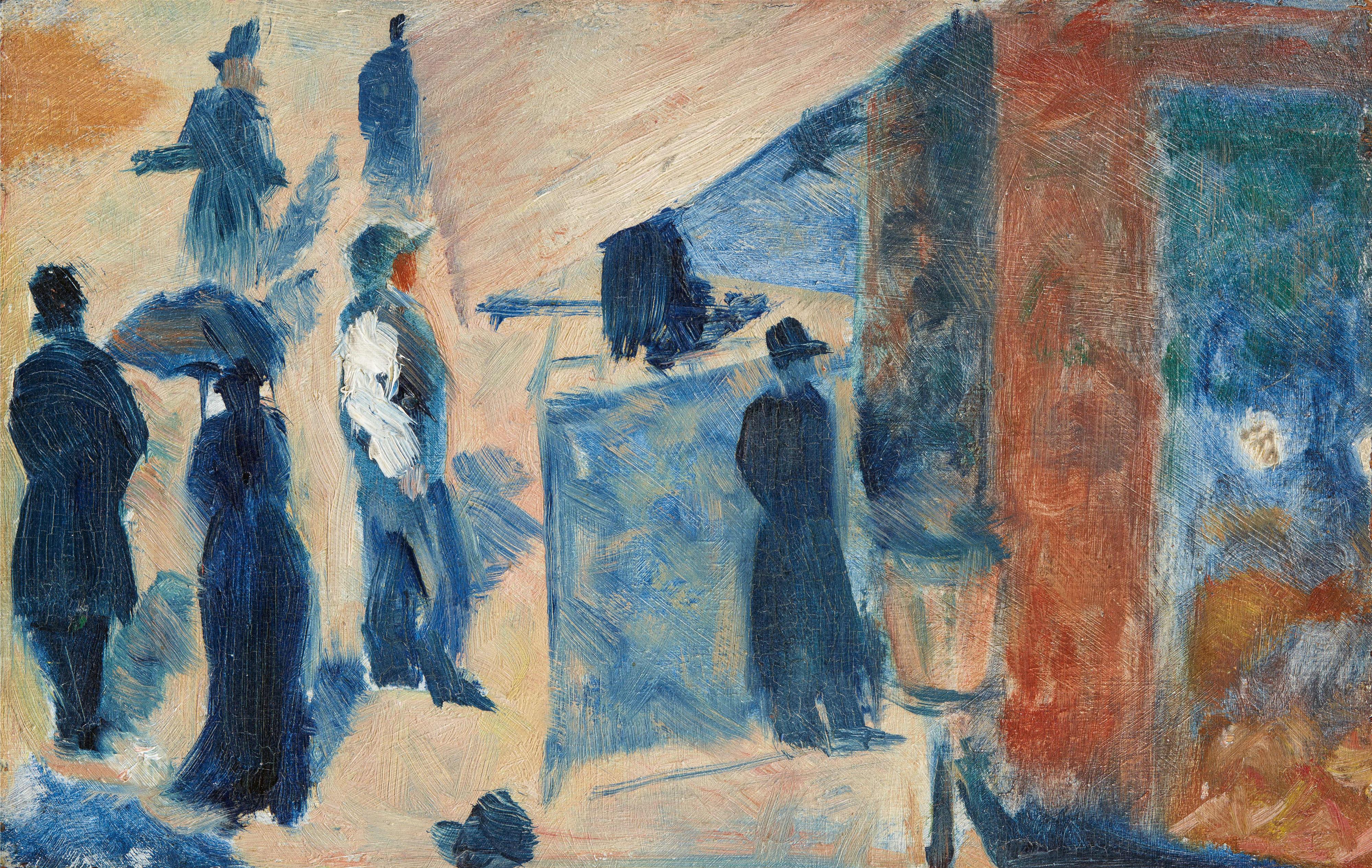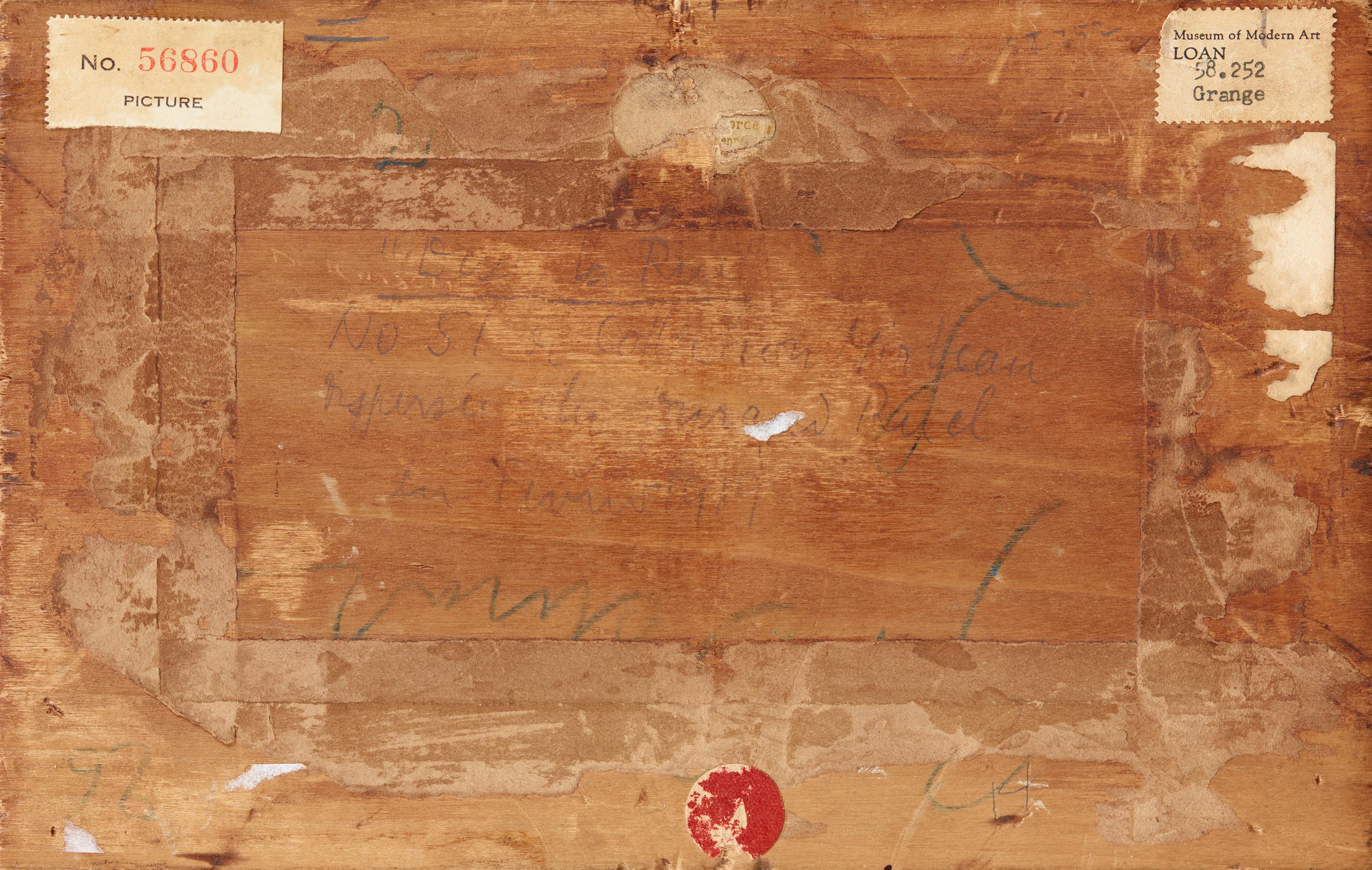Georges Seurat
Dans la rue
1882/1883
Oil on wooden panel. 15.6 x 24.7 cm. Framed. Unsigned. Inscribed "Dans la rue" and "No 51 Collection Mirbeau, dispersé du Durand-Ruel en Février 1919“ in pencil verso, and inscribed "NO. 56860 PICTURE" on a label. - Very good condition with fresh colours.
The study “Dans la rue” displays a captivating use of colour and is one of Georges Seurat’s few pure cityscapes. This subject, which was so popular among the impressionists, made the elegant bourgeoisie in Georges-Eugène Haussmann’s modernised Paris, the sole motif of the picture. From a slightly elevated vantage point – perhaps from his studio in the bustling Boulevard de Clichy – Seurat has fixed his gaze on the flâneurs strolling along the street. In a manner comparable to the famous urban image “Paris Street; Rainy Day” (1877) by the French painter of the city Gustave Caillebotte, Seurat has also composed two distinct pictorial spaces. To the left there is a broad pavement with six passers-by, some of whom are seen in boldly cropped views, and to the right we see the ground floor of a shop with a large display window. A man in a long coat and hat casually stands in the shadow of a long awning. For the figures, Seurat made use of the numerous pencil sketches he had made of male and female flâneurs between 1882 and 1884, mostly only in the form of silhouettes. In terms of colour, the study ranges along a scale of blue and light-brown tones. Seurat has expertly indicated a shirt sleeve with four brush strokes of pure opaque white.
Georges Seurat is considered the actual inventor of the pointillist painting technique, in which pure colours are applied in usually tiny dots and become mixed only at a distance and in the eye of the viewer. In small-format oil studies like this, also known as “croquetons”, this technique was not yet fully developed. Instead, these studies served him as a way to experiment with the application of paint through minute brushwork and to prepare for works as ambitious as “Un dimanche après-midi à la Grande Jatte”, from 1884–1886.
Catalogue Raisonné
Dorra/Rewald 59
Provenance
Artist's studio (Estate register no. 26); Léon Appert (artist's brother-in.law), Paris (until1900); Octave Mirbeau, Paris; Galerie Durand-Ruel, Paris, Vente Mirbeau, 24.02.1919, lot 51; John Quinn, New York (until 1926); Madame Nicol, Paris; Alfred Daber, Paris; William Weinberg, Scarsdale; Sotheby's London, Weinberg Sale, 10.07.1957, lot 40; T.P. Grange, London; Collection Georges Page, Feldbach; Salis & Vertes (2003), Salzburg; Collection Corboud, long-term loan to Wallraf-Richartz-Museum - Fondation Corboud, Cologne
Literature
Georges Coquiot, Georges Seurat, Paris 1924, p. 247; John Quinn Collection of Paintings, Watercolors, Drawings and Sculpture, Catalogue, New York 1926, p. 15 (?); César M. Hauke, Seurat et son oeuvre, 2 vol., Paris 1961, vol. 1, no. 69, ill. p. 41; Pierre Courthion, Georges Seurat, Paris/New York 1969, p. 84; Michael Zimmermann, Seurat. Sein Werk und die kunsttheoretische Debatte seiner Zeit, Weinheim 1991, p. 126, col.ill. 234; Die Impressionisten und ihre Nachfolger. Die Bilder der Fondation Corboud (Wallraf-Richartz-Museum & Fondation Corboud Cologne, illustrated book of the collection), ed. by Barbara Schaefer, Cologne 2006, p. 32, 123, col.ill. 22.
Exhibitions
Paris 1900 (La Revue Blanche), Georges Seurat, cat. no. 19; Chicago/New York 1958 (Art Institute of Chicago/Museum of Modern Art), Seurat, cat. no. 60 (adhesive note verso "Museum of Modern Art, Loan, 58.252 Grange"); Paris 1967 (Musée de l'Orangerie), Meisterwerke der Schweizer Sammlungen von Manet bis Picasso, cat. no. 59, with ill.; Salzburg 2003 (Salis & Vertes), Bouquet d'Art. Festspielausstellung 2003, cat. no. 1




